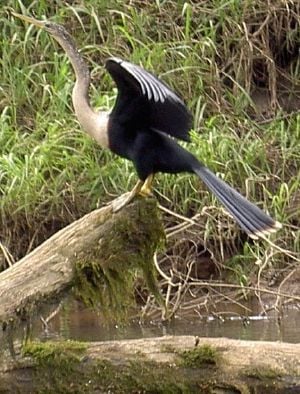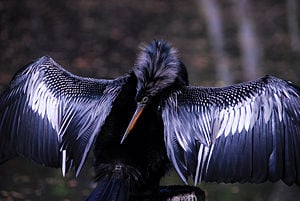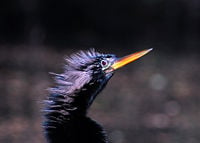Difference between revisions of "Anhinga" - New World Encyclopedia
({{Contracted}}) |
Rick Swarts (talk | contribs) |
||
| Line 1: | Line 1: | ||
{{Claimed}}{{Contracted}} | {{Claimed}}{{Contracted}} | ||
| + | {{Taxobox | ||
| + | | color = pink | ||
| + | | name = Anhinga | ||
| + | | status = LC | ||
| + | | image = Anhinga-in-flight.jpg | ||
| + | | regnum = [[Animal]]ia | ||
| + | | phylum = [[Chordate|Chordata]] | ||
| + | | classis = [[Aves]] | ||
| + | | ordo = [[Pelecaniformes]] | ||
| + | | familia = [[Darter|Anhingidae]] | ||
| + | | genus = ''[[Darter|Anhinga]]'' | ||
| + | | species = '''''A. anhinga''''' | ||
| + | | binomial = ''Anhinga anhinga'' | ||
| + | | binomial_authority = ([[Carolus Linnaeus|Linnaeus]], [[1766]]) | ||
| + | }} | ||
| + | |||
| + | :''For the bird genus '''Anhinga''', see [[Darter]]'' | ||
| + | |||
| + | The '''Anhinga''' (''Anhinga anhinga''), sometimes called '''Snakebird''', '''Darter''', '''American Darter''', or '''Water Turkey''', is a water bird of the warmer parts of [[North America]] and [[South America]]. | ||
| + | |||
| + | It is a [[cormorant]]-like [[bird]] with an average body length of 85 cm (35 in), a wingspan of 117 cm (45 in), and a weight of 1,350 g. It is a dark-plumaged fish-eater with a very long neck, and often swims with only the neck above water. When swimming in this style the name Snakebird is apparent, since only the colored neck appears above water the bird looks like a snake ready to strike. | ||
| + | |||
| + | The Anhinga is a member of the darter family, [[Anhingidae]], and is closely related to [[Oriental Darter|Indian]] (''Anhinga melanogaster''), [[African Darter|African]] (''Anhinga rufa''), and Australian (''Anhinga novaehollandiae'') Darters. | ||
| + | |||
| + | The Anhinga's feathers are not waterproofed by oils like those of [[duck]]s, and can get waterlogged, causing the bird to become barely buoyant. However, this allows it to dive easily and search for fish under the water. It can stay down for significant periods. | ||
| + | |||
| + | [[image:Anhinga b.jpg|left|thumb|Female Anhinga drying its feathers, Costa Rica]] | ||
| + | When necessary, the Anhinga will dry out its wings and feathers. It will perch for long periods with its wings spread to allow the drying process, as do cormorants. If it attempts to fly while its wings are wet, it has great difficulty getting off the water and takes off by flapping vigorously while 'running' on the water. Anhinga will often search for food in small groups. | ||
| + | |||
| + | [[Image:Anhingadrying.jpg|right|thumb|300px|Anhinga drying its' feathers.]] | ||
| + | |||
| + | |||
| + | ==Notes on the family, Anhingidae== | ||
| + | The '''darters''' or snake-birds are birds in the family '''Anhingidae'''. There are four living species, one of which is near-threatened. The darters are frequently referred to as “snake-birds” because of their long thin neck, which gives a snake-like appearance when they swim with their bodies submerged. | ||
| + | |||
| + | The darters are large birds with dimorphic plumage. The males have black and dark brown plumage, an erectile crest on the nape and a larger bill than the female. The females have a much paler plumage especially on the neck and underparts. Both have grey stippling on long scapulars and upper wing coverts. The sharply pointed bill has serrated edges. The darters have completely webbed feet, and their legs are short and set far back on the body. Their plumage is somewhat permeable, like that of [[cormorant]]s, and they spread their wings to dry after diving. Vocalizations include a clicking or rattling when flying or perching. During breeding adults sometimes have ''caw'' or hissing calls. | ||
| + | |||
| + | === Range === | ||
| + | |||
| + | Darters are circum-equatorial, tropical or subtropical. They inhabit either fresh or brackish water and can be found in lakes, rivers, marshes, swamps, estuaries, bays, lagoons and [[mangrove]] swamps. They tend to gather in flocks sometimes up to about 100 birds but are highly territorial when breeding. Most are sedentary and do not [[bird migration|migrate]], however the populations at extreme distributions may migrate. The Oriental Darter is near-threatened species[http://ip30.eti.uva.nl/zma3d/detail.php?taxon=anhingidae&sort=taxon&type=fa]. Habitat destruction along with other human interferences is among the main reasons for a declining population. | ||
| + | |||
| + | === Diet === | ||
| + | Darters feed mainly on fish. They use their sharply pointed bill to spear their prey when they dive; this is how they get the name darter. Their ventral keel is present on the 5-7 vertebrae which allows for muscles to attach so that they are able to project their bill forward like a spear. They also eat amphibians such as frogs and newts, reptiles such as snakes and turtles and invertebrates such as insects, shrimp and mollusks. These birds use their feet to move underwater and quietly stalk and ambush their prey. They then stab the prey, such as a fish, and bring them to the surface where they toss it into the air and catch and swallow it. | ||
| + | |||
| + | [[Image:Snake_bird_nesting.jpg|thumb|250px|Snake birds nesting at Kalletumkara, [[Kerala]]]] | ||
| + | === Breeding === | ||
| + | The darters are monogamous and pair bond during the breeding season. There are many different types of displays used for mating including male displays to attract the female, greeting displays between the male and female and pair bonding displays between the pairs. Also during breeding, their small gular sac changes from pink or yellow to black and the bare facial skin turns to turquoise from a yellow or yellow-green color. They usually breed in colonies. | ||
| + | |||
| + | Breeding can be seasonal or year round and varies by geographic range. The nests are made of twigs and are built in trees or reeds, often near water. The clutch size is two to six eggs (usually about 4) of a pale green color and the eggs are incubated for 25 to 30 days. The eggs hatch asynchronously. [[Bi-parental care]] is given and the young are considered altricial. They reach sexual maturity by about 2 years. These birds generally live to around 9 years. | ||
| + | |||
| + | ===Systematics and evolution=== | ||
| + | |||
| + | This family is very closely related to the other families in the order Pelecaniformes. There are four living species recognized, all in the [[genus]] ''Anhinga'', although the Old World ones are often lumped together as subspecies of ''A. melanogaster''. | ||
| + | [[Image:Darterfemale.jpg|thumb|left|200px|Female Oriental Darter]] | ||
| + | |||
| + | * [[Anhinga]], ''Anhinga anhinga'' | ||
| + | * [[Oriental Darter]], ''Anhinga melanogaster'' | ||
| + | * [[African Darter]], ''Anhinga rufa'' | ||
| + | * [[Australian Darter]], ''Anhinga novaehollandiae'' | ||
| + | |||
| + | Extinct "species" from [[Mauritius]] and [[Australia]] known only from bones were described as ''Anhinga nana'' ("Mauritian Darter") and ''Anhinga parva'', but they were misidentifications of bones of the [[Long-tailed Cormorant]] and the [[Little Pied Cormorant]], respectively (Miller, 1966; Olson, 1975). In the former case, however, they might belong to an extinct subspecies which would have to be called ''Phalacrocorax africanus nanus'' (Mauritian Cormorant) - quite ironically, as ''nana'' means "dwarf" and the remains are ''larger'' than those of the geographically closest population of the Long-tailed Cormorant. | ||
| + | |||
| + | |||
| + | |||
| + | |||
| + | ==Protected status== | ||
| + | The Anhinga is protected in the US under the [[Migratory Bird Treaty Act of 1918]].[http://www.fws.gov/migratorybirds/intrnltr/mbta/mbtandx.html] | ||
| + | |||
| + | [[Image:Anhingaclose.jpg|left|thumb|200px|close up.]] | ||
| + | |||
| + | ==References== | ||
| + | * {{IUCN2006|assessors=BirdLife International|year=2004|id=49544|title=Anhinga anhinga|downloaded=12 May 2006}} Database entry includes justification for why this species is of least concern | ||
| + | |||
| + | * '''Georgia Museum of Natural History''' & '''Georgia Department of Natural Resources''' (2000): [http://museum.nhm.uga.edu/gawildlife/birds/pelecaniformes/pelecaniformes.html Order: Pelicaniformes]. ''In: Georgia Wildlife Web''. Accessed August 30, 2006. | ||
| + | |||
| + | * '''Lockwood''', Burleigh (2006): [http://www.chaffeezoo.org/animals/pelecaniformes.html Pelecaniformes]. ''Fresno Chaffee Zoo''. Accessed August 30, 2006. | ||
| + | |||
| + | * '''Miller''', Alden H. (1966): An Evaluation of the Fossil Anhingas of Australia. ''[[Condor (journal)|Condor]]'' '''68'''(4): 315-320. [http://elibrary.unm.edu/sora/Condor/files/issues/v068n04/p0315-p0320.pdf PDF fulltext] | ||
| + | |||
| + | * '''Myers''', P.; Espinosa, R.; Parr, C. S.; Jones, T.; Hammond, G. S. & Dewey, T. A. (2006): [http://animaldiversity.ummz.umich.edu/site/accounts/information/Anhingidae.htm Anhingidae]. ''In: The Animal Diversity Web (online)''. Accessed August 29, 2006. | ||
| + | |||
| + | * '''Olson''', Storrs L. (1975): An Evaluation of the Supposed ''Anhinga'' of Mauritius. ''[[Auk (journal)|Auk]]'' '''92''':374-376. [http://elibrary.unm.edu/sora/Auk/v092n02/p0374-p0376.pdf PDF fulltext] | ||
| + | |||
| + | ==External links== | ||
| + | * [http://ibc.hbw.com/ibc/phtml/especie.phtml?idEspecie=271 Anhinga videos] on the Internet Bird Collection | ||
| + | |||
| + | [[Category:Life sciences]] | ||
| + | [[Category:Animals]] | ||
| + | [[Category:Birds]] | ||
| + | {{credit|Anhinga|157191708|Darter|158503938}} | ||
Revision as of 11:57, 25 September 2007
| Anhinga | ||||||||||||||
|---|---|---|---|---|---|---|---|---|---|---|---|---|---|---|
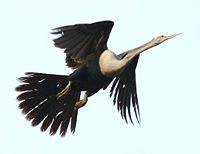 | ||||||||||||||
| Scientific classification | ||||||||||||||
| ||||||||||||||
| Anhinga anhinga (Linnaeus, 1766) |
- For the bird genus Anhinga, see Darter
The Anhinga (Anhinga anhinga), sometimes called Snakebird, Darter, American Darter, or Water Turkey, is a water bird of the warmer parts of North America and South America.
It is a cormorant-like bird with an average body length of 85 cm (35 in), a wingspan of 117 cm (45 in), and a weight of 1,350 g. It is a dark-plumaged fish-eater with a very long neck, and often swims with only the neck above water. When swimming in this style the name Snakebird is apparent, since only the colored neck appears above water the bird looks like a snake ready to strike.
The Anhinga is a member of the darter family, Anhingidae, and is closely related to Indian (Anhinga melanogaster), African (Anhinga rufa), and Australian (Anhinga novaehollandiae) Darters.
The Anhinga's feathers are not waterproofed by oils like those of ducks, and can get waterlogged, causing the bird to become barely buoyant. However, this allows it to dive easily and search for fish under the water. It can stay down for significant periods.
When necessary, the Anhinga will dry out its wings and feathers. It will perch for long periods with its wings spread to allow the drying process, as do cormorants. If it attempts to fly while its wings are wet, it has great difficulty getting off the water and takes off by flapping vigorously while 'running' on the water. Anhinga will often search for food in small groups.
Notes on the family, Anhingidae
The darters or snake-birds are birds in the family Anhingidae. There are four living species, one of which is near-threatened. The darters are frequently referred to as “snake-birds” because of their long thin neck, which gives a snake-like appearance when they swim with their bodies submerged.
The darters are large birds with dimorphic plumage. The males have black and dark brown plumage, an erectile crest on the nape and a larger bill than the female. The females have a much paler plumage especially on the neck and underparts. Both have grey stippling on long scapulars and upper wing coverts. The sharply pointed bill has serrated edges. The darters have completely webbed feet, and their legs are short and set far back on the body. Their plumage is somewhat permeable, like that of cormorants, and they spread their wings to dry after diving. Vocalizations include a clicking or rattling when flying or perching. During breeding adults sometimes have caw or hissing calls.
Range
Darters are circum-equatorial, tropical or subtropical. They inhabit either fresh or brackish water and can be found in lakes, rivers, marshes, swamps, estuaries, bays, lagoons and mangrove swamps. They tend to gather in flocks sometimes up to about 100 birds but are highly territorial when breeding. Most are sedentary and do not migrate, however the populations at extreme distributions may migrate. The Oriental Darter is near-threatened species[1]. Habitat destruction along with other human interferences is among the main reasons for a declining population.
Diet
Darters feed mainly on fish. They use their sharply pointed bill to spear their prey when they dive; this is how they get the name darter. Their ventral keel is present on the 5-7 vertebrae which allows for muscles to attach so that they are able to project their bill forward like a spear. They also eat amphibians such as frogs and newts, reptiles such as snakes and turtles and invertebrates such as insects, shrimp and mollusks. These birds use their feet to move underwater and quietly stalk and ambush their prey. They then stab the prey, such as a fish, and bring them to the surface where they toss it into the air and catch and swallow it.
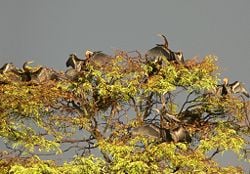
Breeding
The darters are monogamous and pair bond during the breeding season. There are many different types of displays used for mating including male displays to attract the female, greeting displays between the male and female and pair bonding displays between the pairs. Also during breeding, their small gular sac changes from pink or yellow to black and the bare facial skin turns to turquoise from a yellow or yellow-green color. They usually breed in colonies.
Breeding can be seasonal or year round and varies by geographic range. The nests are made of twigs and are built in trees or reeds, often near water. The clutch size is two to six eggs (usually about 4) of a pale green color and the eggs are incubated for 25 to 30 days. The eggs hatch asynchronously. Bi-parental care is given and the young are considered altricial. They reach sexual maturity by about 2 years. These birds generally live to around 9 years.
Systematics and evolution
This family is very closely related to the other families in the order Pelecaniformes. There are four living species recognized, all in the genus Anhinga, although the Old World ones are often lumped together as subspecies of A. melanogaster.
- Anhinga, Anhinga anhinga
- Oriental Darter, Anhinga melanogaster
- African Darter, Anhinga rufa
- Australian Darter, Anhinga novaehollandiae
Extinct "species" from Mauritius and Australia known only from bones were described as Anhinga nana ("Mauritian Darter") and Anhinga parva, but they were misidentifications of bones of the Long-tailed Cormorant and the Little Pied Cormorant, respectively (Miller, 1966; Olson, 1975). In the former case, however, they might belong to an extinct subspecies which would have to be called Phalacrocorax africanus nanus (Mauritian Cormorant) - quite ironically, as nana means "dwarf" and the remains are larger than those of the geographically closest population of the Long-tailed Cormorant.
Protected status
The Anhinga is protected in the US under the Migratory Bird Treaty Act of 1918.[2]
ReferencesISBN links support NWE through referral fees
- BirdLife International 2004. [3]. 2006 IUCN Red List of Threatened Species., World Conservation Union. Retrieved on 12 May 2006. Database entry includes justification for why this species is of least concern
- Georgia Museum of Natural History & Georgia Department of Natural Resources (2000): Order: Pelicaniformes. In: Georgia Wildlife Web. Accessed August 30, 2006.
- Lockwood, Burleigh (2006): Pelecaniformes. Fresno Chaffee Zoo. Accessed August 30, 2006.
- Miller, Alden H. (1966): An Evaluation of the Fossil Anhingas of Australia. Condor 68(4): 315-320. PDF fulltext
- Myers, P.; Espinosa, R.; Parr, C. S.; Jones, T.; Hammond, G. S. & Dewey, T. A. (2006): Anhingidae. In: The Animal Diversity Web (online). Accessed August 29, 2006.
- Olson, Storrs L. (1975): An Evaluation of the Supposed Anhinga of Mauritius. Auk 92:374-376. PDF fulltext
External links
- Anhinga videos on the Internet Bird Collection
Credits
New World Encyclopedia writers and editors rewrote and completed the Wikipedia article in accordance with New World Encyclopedia standards. This article abides by terms of the Creative Commons CC-by-sa 3.0 License (CC-by-sa), which may be used and disseminated with proper attribution. Credit is due under the terms of this license that can reference both the New World Encyclopedia contributors and the selfless volunteer contributors of the Wikimedia Foundation. To cite this article click here for a list of acceptable citing formats.The history of earlier contributions by wikipedians is accessible to researchers here:
The history of this article since it was imported to New World Encyclopedia:
Note: Some restrictions may apply to use of individual images which are separately licensed.

